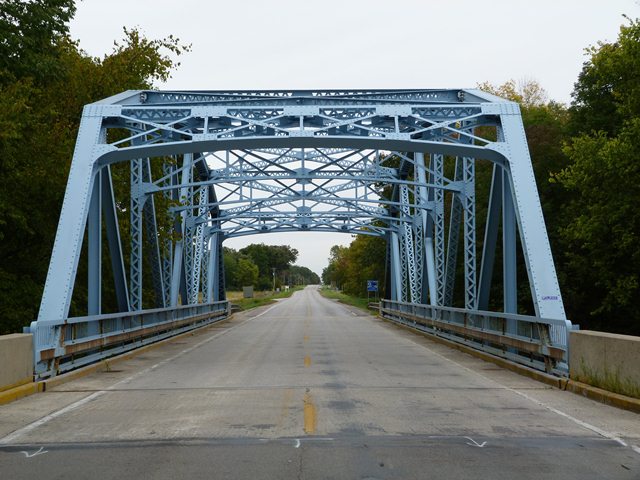We Recommend:
Bach Steel - Experts at historic truss bridge restoration.
BridgeHunter.com Phase 1 is released to the public! - Visit Now
IN-26 Bridge

Primary Photographer(s): Nathan Holth and Rick McOmber
Bridge Documented: September 21, 2012
Portland: Jay County, Indiana: United States
1941 By Builder/Contractor: Yost Brothers of Decatur, Indiana and Engineer/Design: Indiana State Highway Commission
1979
150.0 Feet (45.7 Meters)
155.0 Feet (47.2 Meters)
28 Feet (8.53 Meters)
1 Main Span(s)
7040

View Information About HSR Ratings
Bridge Documentation
View Archived National Bridge Inventory Report - Has Additional Details and Evaluation
An irony in Indiana is that often the heavier state standard truss bridges like this bridge are often demolished and replaced, while older, lighter weight bridges have a higher rate of preservation. This is because the amount of historic truss bridge preservation in Indiana on local roads and non-motorized trails is well above the sad national average and a significant number of old bridges in rural locations in Indiana are preserved. However, InDOT, which owns the major highways that standard plan truss bridges tend to show up on has a much lower rate of preservation and continues to demolish an alarming number of historic bridges under its jurisdiction. This is unfortunate because these heavy truss bridges with fairly wide roadways are easy to preserve for continued vehicular use. This bridge however remains in good condition and is not currently threatened with demolition.
Information and Findings From DHPA Historic Bridge SurveyStatement of Significance This bridge represents the IDH's revised standard and additionally-braced design for 150' Parkers with wide decks. The structure appears to retain its original members, including the metal guardrails. The concrete approach rails are replacements. Architectural Description The Indiana Department of Highways significantly modified its standard 150' Parker through-truss design in the late 1930s to accommodate roadways wider than 25'. The revised design reduced the number of panels,
relied more heavily upon rolled I beams in the webbing and lower chord members, and stiffened the portal bracing. Other Information The Yost Brothers of Decatur, Indiana, successfully bid $48,766.85 in April 1941 to replace a collapsed structure with a new one of state design to be seated upon concrete abutments. The Yosts completed the new
bridge by the end of the year. The ISHC used a fourth-generation standard plan for this 150-ft., riveted, Parker through-truss span with a 26-ft. roadway bordered by 1-ft. 6-in. curbs. Standard #1522 appears to have essentially
followed the earlier #1531 in all except the deck. Truss depth varied from 22 ft. at the portal to 29 ft. 8 in. at midspan. Each truss carried seven panels, the outer two at each end of 20 ft. and the inner three at 23 ft. 4 in. All
top chord members are differently sloped, and only the central panel's is parallel with the lower chord. All were fabricated from a pair of 12-in. channels, the endposts at 35 lbs. and the others at 30 lbs. The lower chord's members
consist of 10-in. rolled I-beams growing in weight from the ends (@54#) towards midspan (@77#). Most of the verticals were made of a pair of latticed 10-in. channels (@15.3#); the hip vertical of a 10-in. I-beam (@33#). To protect
the quite-tall trusses against wind and vehicle-induced stress, substantial latticed struts and heavy upper sway framing buttressed the verticals above the 15 ft. of roadway clearance. The portals also relied on latticed sections.
Even as they shifted between sections, the diagonals grew lighter toward midspan: in the second panel, a 10-in. rolled I-beam (@41#); in the third, a pair of 10-in. channels (@15.3#); in the fourth, a rolled 10-in. I-beam (21#). The
ISHC required 36-in. I floor-beams, growing heavier toward midspan (150#>182#) and riveted to the verticals above the lower chord. Ten rows of 18-in. rolled I-beam stringers, also growing heavier toward midspan (47#>50#), were
attached to the floor-beams' sides. Together, the floor-beams and the stringers carry the concrete deck. Tube-and-post guardrails lined the trusses, while coped concrete rails with bush-hammered panels marked the approaches. Bridge Considered Historic By Survey: Yes |
![]()
Photo Galleries and Videos: IN-26 Bridge
Bridge Photo-Documentation
Original / Full Size PhotosA collection of overview and detail photos. This gallery offers photos in the highest available resolution and file size in a touch-friendly popup viewer.
Alternatively, Browse Without Using Viewer
![]()
Bridge Photo-Documentation
Mobile Optimized PhotosA collection of overview and detail photos. This gallery features data-friendly, fast-loading photos in a touch-friendly popup viewer.
Alternatively, Browse Without Using Viewer
![]()
Eastbound Crossing
Full Motion VideoStreaming video of the bridge. Also includes a higher quality downloadable video for greater clarity or offline viewing.
![]()
Westbound Crossing
Full Motion VideoStreaming video of the bridge. Also includes a higher quality downloadable video for greater clarity or offline viewing.
![]()
Maps and Links: IN-26 Bridge
Coordinates (Latitude, Longitude):
Search For Additional Bridge Listings:
Bridgehunter.com: View listed bridges within 0.5 miles (0.8 kilometers) of this bridge.
Bridgehunter.com: View listed bridges within 10 miles (16 kilometers) of this bridge.
Additional Maps:
Google Streetview (If Available)
GeoHack (Additional Links and Coordinates)
Apple Maps (Via DuckDuckGo Search)
Apple Maps (Apple devices only)
Android: Open Location In Your Map or GPS App
Flickr Gallery (Find Nearby Photos)
Wikimedia Commons (Find Nearby Photos)
Directions Via Sygic For Android
Directions Via Sygic For iOS and Android Dolphin Browser
USGS National Map (United States Only)
Historical USGS Topo Maps (United States Only)
Historic Aerials (United States Only)
CalTopo Maps (United States Only)


